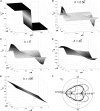Representation of collective electrical behavior of cardiac cell sheets
- PMID: 18469085
- PMCID: PMC2479607
- DOI: 10.1529/biophysj.107.128207
Representation of collective electrical behavior of cardiac cell sheets
Abstract
The electrocardiogram (ECG) is a measure of the collective electrical behavior of the heart based on body surface measurements. With computational models or tissue preparations, various methods have been used to compute the pseudo-ECG (pECG) of bipolar and unipolar leads that can be given clinical interpretation. When spatial maps of transmembrane potential (V(m)) are available, pECG can be derived from a weighted sum of the spatial gradients of V(m). The concept of a lead field can be used to define sensitivity curves for different bipolar and unipolar leads and to determine an effective operating height for the bipolar lead position for a two-dimensional sheet of heart cells. The pseudo-vectorcardiogram (pVCG) is computed from orthogonal bipolar lead voltages, which are derived in this study from optical voltage maps of cultured monolayers of cardiac cells. Rate and propagation direction for paced activity, rotation frequency for reentrant activity, direction of the common pathway for figure-eight reentry, and transitions from paced activity to reentry can all be distinguished using the pVCG. In contrast, the unipolar pECG does not clearly distinguish among many of the different types of electrical activity. We also show that pECG can be rapidly computed by two geometrically weighted sums of V(m), one that is summed over the area of the cell sheet and the other over the perimeter of the cell sheet. Our results are compared with those of an ad hoc difference method used in the past that consists of a simple difference of the sum of transmembrane potentials on one side of a tissue sheet and that of the other.
Figures









Similar articles
-
The effect of the cut surface during electrical stimulation of a cardiac wedge preparation.IEEE Trans Biomed Eng. 2006 Jun;53(6):1187-90. doi: 10.1109/TBME.2006.873386. IEEE Trans Biomed Eng. 2006. PMID: 16761846
-
The inverse problem of bioelectricity: an evaluation.Med Biol Eng Comput. 2012 Sep;50(9):891-902. doi: 10.1007/s11517-012-0941-5. Epub 2012 Jul 28. Med Biol Eng Comput. 2012. PMID: 22843426 Review.
-
Examination of depth-weighted optical signals during cardiac optical mapping: a simulation study.Comput Biol Med. 2007 May;37(5):732-8. doi: 10.1016/j.compbiomed.2006.07.004. Epub 2006 Sep 20. Comput Biol Med. 2007. PMID: 16987506
-
Quantitative prediction of body surface potentials from myocardial action potentials using a summed dipole model.Cardiovasc Eng. 2009 Jun;9(2):59-71. doi: 10.1007/s10558-009-9075-2. Epub 2009 Jun 20. Cardiovasc Eng. 2009. PMID: 19543975
-
Crosstalk between theoretical and experimental studies for the understanding of cardiac electrical impulse propagation.J Electrocardiol. 2007 Nov-Dec;40(6 Suppl):S136-41. doi: 10.1016/j.jelectrocard.2007.05.026. J Electrocardiol. 2007. PMID: 17993310 Review. No abstract available.
Cited by
-
Membrane capacitive memory alters spiking in neurons described by the fractional-order Hodgkin-Huxley model.PLoS One. 2015 May 13;10(5):e0126629. doi: 10.1371/journal.pone.0126629. eCollection 2015. PLoS One. 2015. PMID: 25970534 Free PMC article.
-
Chaotic tip trajectories of a single spiral wave in the presence of heterogeneities.Phys Rev E. 2019 Jun;99(6-1):062409. doi: 10.1103/PhysRevE.99.062409. Phys Rev E. 2019. PMID: 31330597 Free PMC article.
-
High-frequency stimulation of excitable cells and networks.PLoS One. 2013 Nov 20;8(11):e81402. doi: 10.1371/journal.pone.0081402. eCollection 2013. PLoS One. 2013. PMID: 24278435 Free PMC article.
-
Modeling hypothermia induced effects for the heterogeneous ventricular tissue from cellular level to the impact on the ECG.PLoS One. 2017 Aug 16;12(8):e0182979. doi: 10.1371/journal.pone.0182979. eCollection 2017. PLoS One. 2017. PMID: 28813535 Free PMC article.
-
Spatial reproducibility of complex fractionated atrial electrogram depending on the direction and configuration of bipolar electrodes: an in-silico modeling study.Korean J Physiol Pharmacol. 2016 Sep;20(5):507-14. doi: 10.4196/kjpp.2016.20.5.507. Epub 2016 Aug 26. Korean J Physiol Pharmacol. 2016. PMID: 27610037 Free PMC article.
References
-
- Alexander, R. W., J. W. Hurst, and R. C. Schlant. 1994. The Heart, Arteries and Veins. McGraw-Hill, Health Professions Division, New York.
-
- Burashnikov, A., and C. Antzelevitch. 2003. Reinduction of atrial fibrillation immediately after termination of the arrhythmia is mediated by late phase 3 early afterdepolarization-induced triggered activity. Circulation. 107:2355–2360. - PubMed
-
- Wu, T. J., S. F. Lin, J. N. Weiss, C. T. Ting, and P. S. Chen. 2002. Two types of ventricular fibrillation in isolated rabbit hearts: importance of excitability and action potential duration restitution. Circulation. 106:1859–1866. - PubMed
-
- Extramiana, F., and C. Antzelevitch. 2004. Amplified transmural dispersion of repolarization as the basis for arrhythmogenesis in a canine ventricular-wedge model of short-QT syndrome. Circulation. 110:3661–3666. - PubMed
-
- Skanes, A. C., R. Mandapati, O. Berenfeld, J. M. Davidenko, and J. Jalife. 1998. Spatiotemporal periodicity during atrial fibrillation in the isolated sheep heart. Circulation. 98:1236–1248. - PubMed
Publication types
MeSH terms
Grants and funding
LinkOut - more resources
Full Text Sources
Miscellaneous

